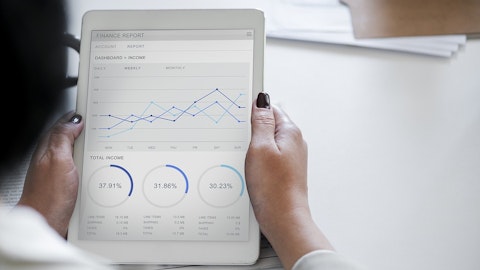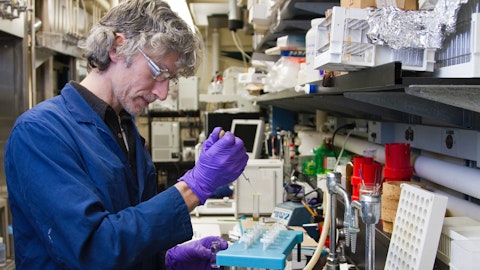The J. M. Smucker Company (NYSE:SJM) Q2 2023 Earnings Call Transcript November 21, 2022
The J. M. Smucker Company beats earnings expectations. Reported EPS is $2.4, expectations were $2.19.
Operator: Good morning, and welcome to The J.M. Smucker Company’s Fiscal 2023 Second Quarter Earnings Question-and-Answer Session. This conference is being recorded. I will now turn the conference call over to Aaron Broholm, Vice President, Investor Relations. Please go ahead, sir.

Photo by Riccardo Greg on Unsplash
Aaron Broholm: Good morning, and thank you for joining our fiscal 2023 second quarter earnings question-and-answer session. I hope everyone had a chance to review our results as detailed in this morning’s press release and management’s prepared remarks, which are available on our corporate website at jmsmucker.com. We will also post an audio replay of this call at conclusion of this morning’s Q&A session. During today’s call, we may make forward-looking statements that reflect our current expectations about future plans and performance. These statements rely on assumptions and estimates, and actual results may differ materially due to risks and uncertainties. Additionally, we use non-GAAP results to evaluate performance internally.
See also 12 Most Advanced Countries in Biotechnology and Lithium Stocks List: 15 Biggest Companies.
I encourage you to read the full disclosure concerning forward-looking statements and details on our non-GAAP measures in this morning’s press release. Participating on this call are Mark Smucker, Chair of the Board, President and Chief Executive Officer; and Tucker Marshall, Chief Financial Officer. We will now open up the call for questions. Operator, please queue up the first question.
Q&A Session
Follow J M Smucker Co (NYSE:SJM)
Follow J M Smucker Co (NYSE:SJM)
Operator: Our first question today comes from Andrew Lazar from Barclays.
Andrew Lazar: I was hoping to start off on gross margin, if we could. I guess excluding the impact from the Jif recall in the quarter, trying to get a sense of what adjusted gross margin would have looked like and whether that would have been a sequential improvement from fiscal 1Q, again, excluding the Jif recall? Basically, I’m just trying to get an understanding of what sort of underlying gross margin trends look like? And maybe more importantly, what caused the move to highlight a full year gross margin now at the low end of the previous range?
Tucker Marshall: Andrew, good morning. We believe there was about a 50 basis point impact to the second quarter as a result of the Jif peanut butter product recall. So we would have been at a 33.7% gross profit margin as compared to the 33.2% that we reported. We remain very confident in the outlook for our gross profit margin for the full fiscal year and have really focused in on the 33.5%. Again, that does have a 100 basis point impact due to the peanut butter recall. And I would also acknowledge that it also accounts for material year-over-year cost inflation where we have told folks that we would be mid-to-high teen increases in our total cost of product goods sold and we are also seeing the impact of business volume mix on that gross margin for the full year. As we continue to work through the second and third quarters, we would anticipate the gross margin improve, with the fourth quarter being our best gross margin quarter.
Andrew Lazar : Great. And then you are flowing through to the full year a bit less than the fiscal 2Q upside you saw in EPS. I guess, what are any discrete reasons for this? Or is there perhaps still some conservatism built in, just given how dynamic the environment continues to be?
Tucker Marshall : Andrew, we’re pleased to be able to take both our top line and bottom line guidance up. Let me begin with the top line. We are taking the midpoint of our previous guidance range, up 150 basis points to approximately 6% on a reported basis. When you think of that 150 basis points, it’s really coming across continued momentum in our pet portfolio and our consumer portfolio as well, along with expectations coming out of the first quarter for our coffee portfolio playing out as expected. And as you translate the $0.15 improvement to the bottom line of our adjusted earnings per share, going now up to $8.55 at the midpoint as compared to $8.40, that $0.15 benefit is really broken down by two things. One, $0.27 benefit from the volume mix due to the top line uplift, offset by $0.12 of additional investment primarily through SD&A for business initiatives.
And then I do want to call out that the portion of our second quarter over-delivery was due to timing of SD&A expenses that will reverse into the third quarter, and that was also what is causing the new outlook for the third quarter. But again, we are taking both top line and bottom line up
Operator: The next question today is coming from Peter Galbo from Bank of America.
Peter Galbo: Tucker, maybe we could just unpack a bit on the top line or the revised top line. Is it fair to assume that the full raise is really on the volume mix side? I think previously, you had said you had about 15 points of price that you expected for the year. I just wanted to make sure that, that number hadn’t moved.
Tucker Marshall: That is correct. It’s largely driven by volume mix across our portfolio.





